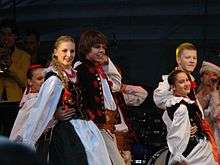Polish folk dances

Polish folk dance is a tradition rooted in many centuries of Polish culture. Many of the dances stem from traditions or historical events, but also include ballroom and ballet style elements. Nowadays, they are typically danced by small companies on major holidays and events.
Overview
Polish folk dances (singular: taniec ludowy, pronounced [ˈtaɲɛts luˈdɔvɨ]; plural: tańce ludowe [ˈtaɲtsɛ luˈdɔvɛ]) tend to be lively, energetic, and joyful. Hops, twirls, and athletic movements are common. Many dances involve a circle (Polish: koło [ˈkɔwɔ] "circle", kołem [ˈkɔwɛm] "in a circle") but also partners.
Dress
Polish costumes are a wide variety depending on each region; there is no "one" polish costume. Western Poland (Silesia, Pomerania) feature more Germanised styles, usually less embroidery than its counterparts in Eastern Poland. Northern Poland has some influence from its northern neighbors, like Sweden and Norway, and includes elements like bonnets in their attire. Central Poland (Masovia, mainly Lowicz and Opoczno), were influenced by their eastern neighbors. The south of Poland is very much influenced by the Carpathian style. Their clothing is commonly worn in Ukraine/Slovakia/Poland/Romania as they all share a bit of the Carpathian Mountains, and this style evolved. In the east of Poland the clothing is greatly influenced by east Slavic folk dress(Russian/Ukraine) as well as their own touches. Places like 'Kresy'(Lost Polish Lands which now belong to Belarus/Ukraine/Lithuania) where very similar to the Russian folk dress, this is mainly because Poland shared a bigger border with Russia, and this resulted in the more colorful dress, also the east is more Slavic in their attire, than the West of Poland. The Lemkowie people (inhabited in Poland/Ukraine/Slovakia) also share their folk-dress with their eastern counterparts. The Common elements in Polish costumes feature coral necklaces for the women, hats and capes for the men, Large Flower crowns, colorful head scarfs, for women. Also the Fur hats(commonly worn in Russia by men/women), and plenty more. Traditionally, a married woman wears a headscarf and unmarried girls wear flowers in their hair.
National Dances
The Polish national dances are the Krakowiak, Kujawiak, Mazurek, Oberek, and Polonaise. These dances are classified as National, because almost every region in Poland has displayed a variety of these dances. Many of these dances were brought to the ballroom floor following Napoleon's expansion into Eastern Europe, which brought French nobility imitating the Polish peasants style of dance, and adding flavors of ballet.
Krakowiak
The Krakowiak (pronounced [kraˈkɔvʲak]) is a fast, syncopated Polish dance in duple time from the region of Kraków and Lesser Poland.
Kujawiak
The Kujawiak [kuˈjavʲak] is a dance from the region of Kuyavia in central Poland. The most romantic of the national dances, the Kujawiak is a slow dance in 3
4 meter, danced with couples.
Mazur
The Mazur is a faster dance in which pairs glide across the floor. The dance is laced heavily with French influences and the dancers move with grace and speed. The Mazur was one of Chopin's biggest influences when composing his music.
Oberek
The Oberek is a fast, vivacious dance in 3
8 time. The word "oberek" is derived from "obrot" meaning, "to turn". Great leaps and feats of athleticism are demonstrated by the men.
Polonaise
The Polonaise is the most stately of the national dances. Danced in 3
4 meter, the Polonaise is often the first dance at large events. In Poland, the Polonaise is called the Polonez, or less often the Chodzony (literally, "walking dance").
Regional Dances
Polish regional dances are ones specific to a given region or city.

Podhale
Southern Poland features the culture of the Gorals (Polish highlanders). These dances were brought to this mountain areas with Vlach settlers in the 17th century. Very similar versions can be found at the Gorols in Slovakia and in Czech Republic. The rhythm of their music is different for the otherwise duple or triple-meter of the lowlands.
Silesia
Silesia was for many centuries a German controlled region with a thriving Polish minority in Upper Silesia. Its songs and dances are simpler and easier.
Silesian songs like Szła Dzieweczka(The Walking Girl) have been popularized in Poland and abroad thanks to state ensembles Śląsk Song and Dance Ensemble and Mazowsze (folk group).
Beskids
The Beskid regions, Slask and Zywiec, are located in the South Western Poland.
Warmia and Cashubia
These sea regions have songs and dances focusing imitating sailors and their northern neighbors.
Rzeszow Voivodeship
The songs and dances from the Rzeszow area are focused on being playful. The eastern border of the Voivodeship has a great Ukrainian influence.
Lublin
The Lublin area is the most colorful of all the Polish regions. Its dances contain fast polkas like the Cygan ("Gypsy") and Polka Podlaska("Podlachian Polka").
Songs
Polish folk songs fall under three categories, love, religion, and Happiness.
Folk groups
Polish Folk Song and Dance groups (in Polish: Zespół Pieśni i Tańca or ZPiT) include:
